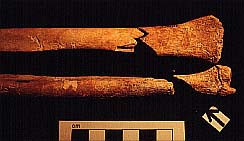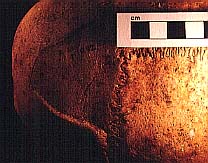Human Bone Gallery - Trauma: wounds
 |
Weapon cutsSite: Harroway Farm, Andover, Hampshire. Catalogue entry: This skeleton was very interesting pathologically, showing a number of unhealed cut marks, one of which is likely to have been fatal. Unfortunately the leg bones were missing, so it is not possible to be certain of the full extent of his injuries. All the wounds were on the left side of the body, and at least two were made from behind. These were a 36mm-long cut on the back of the head, at the left side of the occiptal, which had removed a flake of bone below but did not pierce the brain, and a cut through the left transverse process of the sixth thoracic vertebra, which severed the tip from the rest of the bone. None of the other vertebrae or the ribs appeared to be affected, but preservation was not good in this area. Another cut had sliced through the left hand from the palmar side, removing half of the middle finger, the whole index finger, and nicking the metacarpal of the thumb. The fatal wound was probably the one cutting through the left wrist. This cut straight through the end of the ulna and halfway through the radius, possibly breaking the rest of the bone, and is unlikely to have missed the ulnar artery. Unless there was another wound elsewhere in the body which avoided marking the bones which have survived, it is likely that this individual bled to death, perhaps after being rendered unconscious by the blow to the head. It is unfortunate that his skeleton was not better preserved. |

